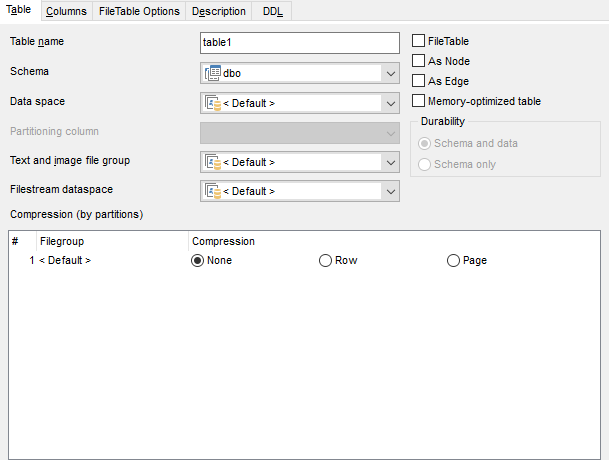Online Documentation for SQL Manager for SQL server
Setting table properties
Use the Table tab of Table Editor to create a table and specify its properties.
Table name
Enter a name for the new table. Note that table names must comply with the rules for identifiers and must be unique within the schema. A table name can contain a maximum of 128 characters.
Schema
Use the drop-down list to select the schema to which the table belongs. The default selection is the default schema for the current user.

![]() File table
File table
Check this option to enable file and directory storage in the database. A FileTable is a specialized user table with a pre-defined schema that stores FILESTREAM data, as well as file and directory hierarchy information and file attributes.
![]() As Node
As Node
Check this option to create a node table for SQL Graph.
![]() As Edge
As Edge
Check this option to create an edge table for SQL Graph.
![]() Memory-optimized table
Memory-optimized table
Check this option to enable memory-optimized table creation. Memory-optimized tables are in memory user tables, the schema of which is persisted on disk similar to other user tables.
If you have selected to create a memory-optimized table, you must specify memory-optimized table indices.
Durability
![]() Schema and data
Schema and data
This value indicates that the table is a durable memory-optimized table. This option provides durability of both schema and data.
![]() Schema only
Schema only
This value indicates that the table is non-durable. This option ensures durability of the table schema, including indexes.
Such tables are not logged and their data is not persisted on disk.
Data space
Use the drop-down list to specify the new table data storage (a file group or a partition scheme).
Partitioning column
This drop-down list is only available if a partition scheme is specified for Data space. Select a field that will be used as the partitioning column for the table.
Text and image file group
Use the drop-down list to select the file group where data of the text and image types will be stored.
If necessary, you can also use the Description area to supply a description for the table being created.
For SQL Server 2008 and higher, Table Editor provides some additional table properties to define:
Filestream dataspace
Select the needed Filestream filegroup from the drop-down list.
Compression (by partitions)
Use this area to set compression options for the table. Compression type can be different for each table partition. Set the partition compression to Row or Page. Set None to leave a partition uncompressed.
To compile the table, use the ![]() Compile item available within the Navigation bar.
Compile item available within the Navigation bar.


































































